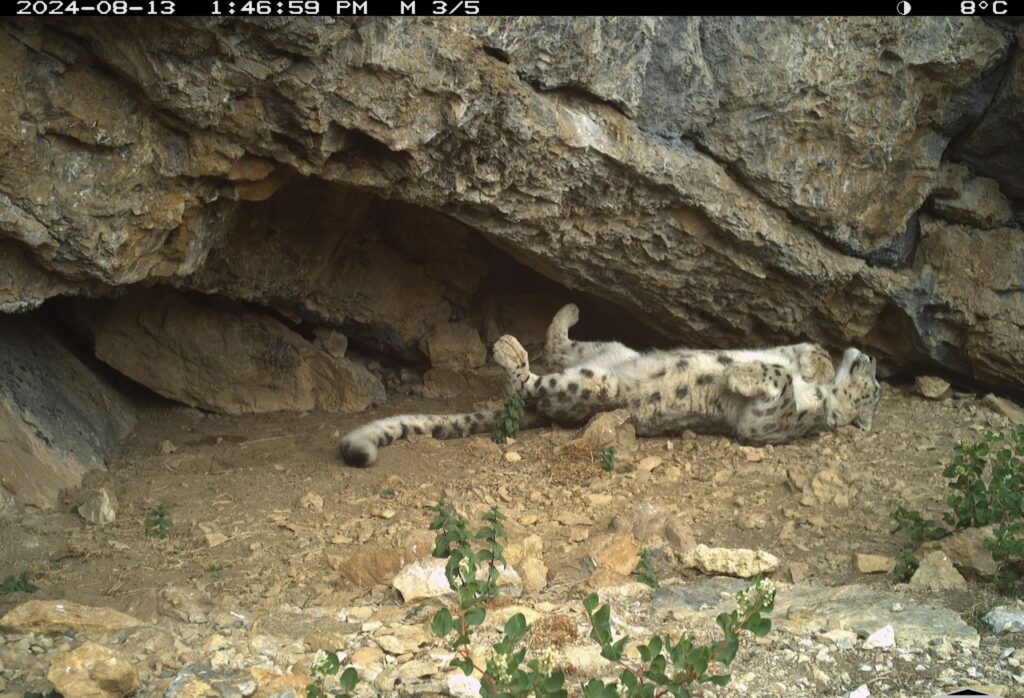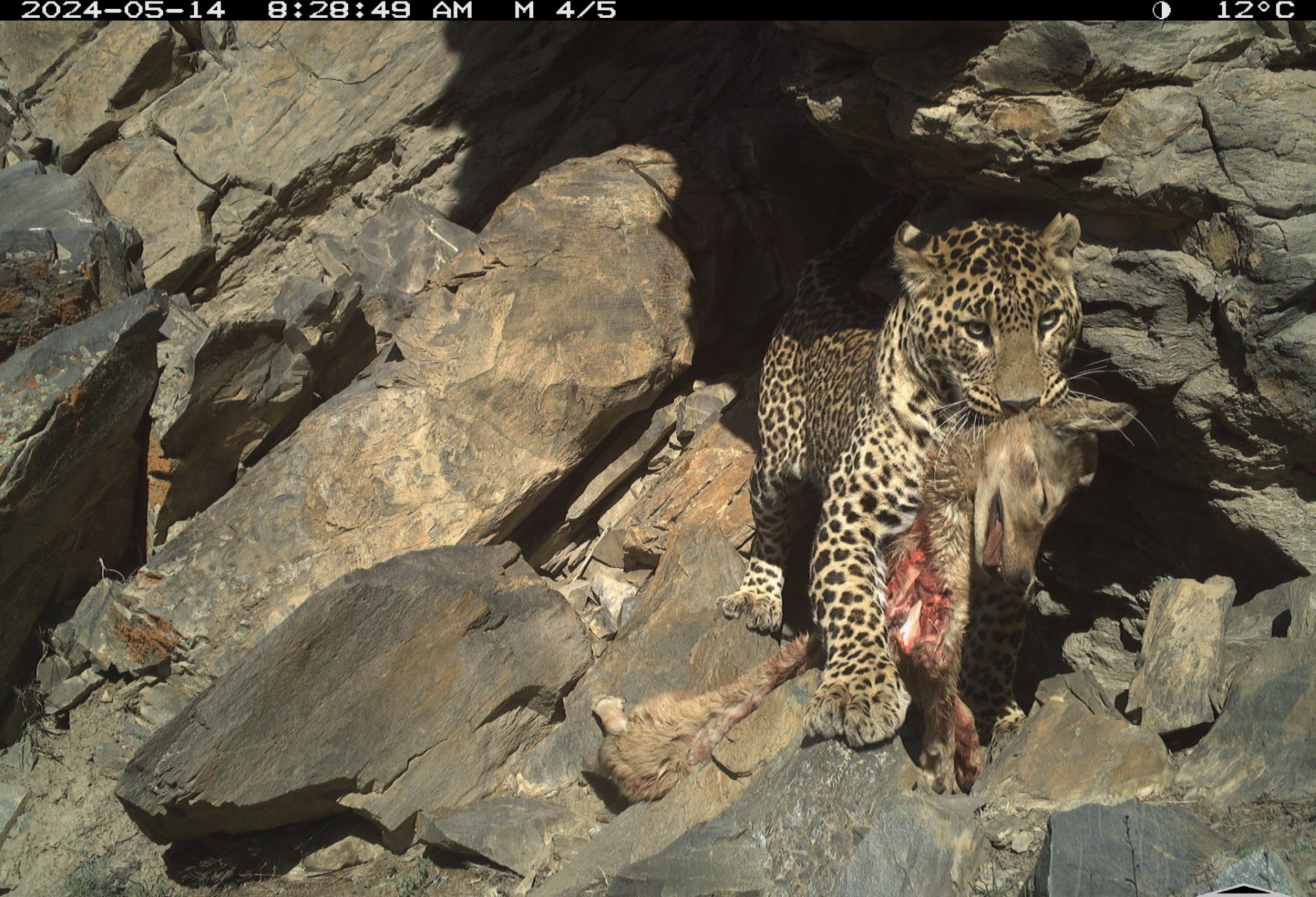- 83 snow leopards estimated across Himachal Pradesh, with 44 unique adults detected in six representative sites
- First official record of Pallas’s cat in Kinnaur and rediscovery of woolly flying squirrel in Lahaul
- Highest densities recorded in Spiti, Pin Valley, Upper Kinnaur, and Tabo regions
- Survey completed in one year using SPAI protocol, making Himachal the only state in India to complete a second state-wide snow leopard population assessment
- Survey was conducted by the Nature Conservation Foundation (NCF) and the Wildlife Wing of the Forest Department, supported by the Snow Leopard Trust (SLT) and Royal Enfield Social Mission
Delhi, October 17, 2025: The Wildlife Wing of the Himachal Pradesh Forest Department has announced the results of the second state-wide snow leopard population assessment, confirming robust numbers of this keystone species across the state’s high-altitude landscapes. Concluded early this year, the survey is the first of its kind in India to be completed in a single year, reaffirming Himachal Pradesh’s leadership in snow leopard monitoring. This landmark study was carried out by the Nature Conservation Foundation (NCF) and the Wildlife Wing, supported by the Snow Leopard Trust (SLT) and Royal Enfield Social Mission.
Using large‑scale camera‑trapping across six representative sites of the 26,000 km² snow leopard habitat, the survey detected 44 unique adult snow leopards, the same as in the 2021 assessment. These individuals were photographed 262 times, leading to an estimated state-wide population of 83 snow leopards (excluding cubs). The snow leopard density was found to range between 0.16 to 0.53 individuals per 100 km², with the trans-Himalayan regions of Spiti and Pin valley, followed by Upper Kinnaur and Tabo, recording the highest densities.
Mr. Amitabh Gautam, Chief Wildlife Warden, Himachal Pradesh, said “This study was carried out by the Nature Conservation Foundation (NCF) in partnership with the Wildlife Wing of the Himachal Pradesh Forest Department. The snow leopards in Himachal are under threat, and the Wildlife Wing of the Forest Department is playing a key role in their conservation. Many wild species are on the verge of extinction today, and the wildlife wing of the Forest Department is taking important steps to protect them.”

The scientific techniques deployed for the project followed the Snow Leopard Population Assessment of India (SPAI) protocol, developed by the Ministry of Environment, Forest, and Climate Change (MoEFCC), and aligned with the global standards of the Global Snow Leopard Ecosystem Protection Program (GSLEP). The two-step method involved initial stratification of the habitat using occupancy surveys, followed by camera trapping in the stratified areas. In the second state-wide survey, stratification was refined using data from the first survey, minimizing bias from over-representation of prime habitats. Completing this comprehensive exercise in just one year—compared to three years previously—demonstrates a scalable, cost-effective model for long-term wildlife monitoring.
Dr. Koustubh Sharma, Executive Director, GSLEP said, “Himachal Pradesh is one of the few provinces across the snow leopard range that has already transitioned from contributing to PAWS (Population Assessment of the World’s Snow leopards) to CLAWS (Continuous Long term Assessment of the World’s Snow leopards). As an apex predator, the snow leopard serves as a thermometer of its ecosystem’s health. Continuous monitoring of snow leopard populations in this rapidly changing world are going to be crucial to detect and address threats to an entire ecosystem.”
The results, 83 individuals (range 67–103) compared to 51 (range 44–73) in the previous assessment, indicate a likely increase in population. However, experts note that the difference may also be attributed to improved survey methods, shorter data-collection windows, and possibly greater prey availability, leading to more accurate estimates.

Preeti Bhandari, Chief Conservator of Forests (Wildlife), said, “This survey was completed in just one year, compared to three years for the previous one. It shows how our capacity for large-scale monitoring has improved and how much trust has grown between the department and local communities.”
Goldy Chabra, DCF – Spiti added “Our staff, locals, and research partner – NCF have worked side by side across some of the toughest landscapes of Himachal Pradesh to complete this second assessment of the snow leopard. The findings show that our snow leopard populations remain healthy and that the high mountains continue to hold a remarkable variety of wildlife. Some of it is still unknown to science, as seen in the first records of the Pallas’s cat and the Woolly flying squirrel. Our field visits and camera trap studies have reminded us that trans-Himalayan landscapes are still full of surprises.”
“As they say, none of us is as strong as all of us. This work reflects what is possible when science, community, and management come together with a shared purpose. Our collective responsibility is to reveal the ecological secrets of these landscapes and ensure that these fragile ecosystems keep thriving,” he added.

Beyond snow leopards, the study also analyzed camera trap data to map distributions of other mammals using ensemble modelling. Updated maps were generated for key prey species such as blue sheep (Pseudois nayaur), Himalayan ibex (Capra sibirica), and musk deer (Moschus leucogaster). Other species recorded include the Himalayan wolf, brown bear, common leopard, red fox, stone marten, mountain weasel, and yellow-throated marten. Significantly, the study reported the first official record of Pallas’s cat (Otocolobus manul) in Kinnaur, and the rediscovery of the woolly flying squirrel (Eupetaurus cinereus) in Lahaul.
Deepshikha Sharma, Programme Manager, Nature Conservation Foundation said,“The Trans‑Himalayan region harbors some of the world’s most distinctive ecosystems, yet they remain exceptionally vulnerable to climate change. Tracking keystone species—particularly the snow leopard and its prey, is crucial for gauging how these habitats are shifting. Despite the sheer richness of these mountains, our knowledge is still limited. Through collaborations with the Himachal Pradesh Forest Department, local communities, the Royal Enfield Social Mission, and the Snow Leopard Trust, we have been able to successfully monitor the snow leopard landscape using camera traps. We hope to continue to learn and conserve these ecosystems through participatory research and action.”
The camera trap deployment was led by eight local youth from Kibber village in Spiti, who have been engaged in such studies since 2010. They were joined by 20 frontline officers from the Spiti Forest Division and 15 community members. Notably, this was the first survey globally where an indigenous women’s team from Kibber participated in data analysis—an important milestone in community-based conservation.

Vigyat Singh, Director, Eicher Group Foundation,the CSR arm of Royal Enfield said, “The snow leopard population assessment in Himachal Pradesh is a landmark initiative that showcases the power of collaborative conservation. By deploying scientific techniques and engaging local communities, we’re not only tracking a majestic species but also safeguarding the fragile ecosystems of the Himalayas. This effort sets a new benchmark for long-term wildlife monitoring and underscores the importance of community-led conservation initiatives. We’re proud to be part of this journey, working together to protect the snow leopard and its habitat for generations to come.“
While most snow leopard detections were recorded within protected areas such as Kibber Wildlife Sanctuary, Great Himalayan National Park, Sechu Tuan Nala, and Asrang Wildlife Sanctuaries, many were also found outside protected areas. This underscores the vital role of local communities in safeguarding snow leopard habitats and highlights the growing importance of community-based conservation across the state.
All camera trap images are credited to the Wildlife Wing, Himachal Pradesh Forest Department, and the Nature Conservation Foundation (NCF).

About Key Stone Species Project:
Royal Enfield Social Mission’s conservation efforts extend from keystone species and critical landscapes in the Himalayas to Indian coastlines, with a long-term vision of helping build human-animal harmony through wildlife conservation and nature-linked livelihoods. To promote coexistence and sustainable livelihoods in wildlife habitats, Royal Enfield’s Social Mission continues to collaborate with a range of partners, focusing on the protection of three key species: Snow Leopard, Himalayan Brown Bear, and Golden Langur.
About Royal Enfield Social Mission:
About 75 years ago, the Himalayas became Royal Enfield’s spiritual home. Royal Enfield Social Mission is catalysing an ecosystem of collective action to meet its long term vision of partnering with 100 Himalayan communities by 2030 towards building climate resilience.
The Royal Enfield Social Mission projects and initiatives include ‘The Himalayan Knot’ – a textile conservation project, bringing together pastoral communities, artisans and designers for wider market access; ‘The Himalayan Hub’ – a collective learning center for Climate Resilience; a network of community-run ‘Green Pit Stops’, embodying responsible travel; ‘The Great Himalayan Exploration’ in partnership with UNESCO to document Intangible Cultural Heritage (ICH); the Royal Enfield ‘Ice Hockey League’ promoting rural sports and winter tourism; conserving biodiversity and wildlife through the Keystone Species project; and ‘Helmets for India’ – a road safety initiative.
Through the Social Mission, Royal Enfield is also encouraging and inspiring one million riders to explore sustainably and ‘Leave every place better’.
In addition to the Social Mission, Royal Enfield also works with local communities near its manufacturing plants in Tamil Nadu, focusing on areas such as education, livelihood, sanitation, healthcare etc. Two multi-decade partnerships with Bodh Shiksha Samiti in Rajasthan and Dr. Shroff Charity Eye Hospital in Delhi continue to be supported as legacy projects.
Royal Enfield Social Mission and other CSR initiatives are implemented by Eicher Group Foundation, a section 8 company incorporated in 2015 under the Companies Act of 2013.
For more updates, visit https://socialmission.royalenfield.com/ and follow the @royalenfieldsocialmission on Instagram.

